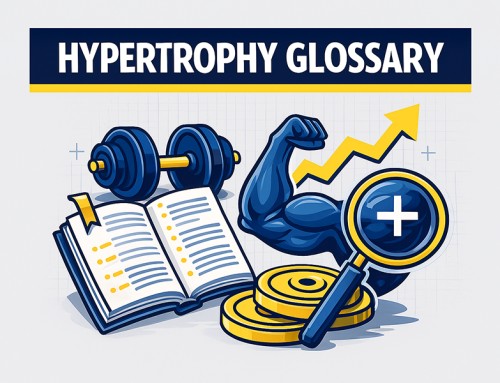In recent Burn the Fat Blog posts and newsletters, we’ve been talking about the key program design variables for muscle growth.
First we talked about weekly training splits and schedules – 2 day upper-lower splits like T.N.B-28 (found in the Burn the Fat, Feed the Muscle book), 3 Day splits like push-pull-legs or 3-day classic muscle and then I introduced the new Hybrid 2/3 split. All of these great options.
I also discussed the ideal number of reps. I revealed the latest scientific discovery that you can gain muscle with almost any rep range if you do enough volume and train to failure when using high reps (though 6 to 20 reps is a sweet spot).
And I revealed the “magic” number of sets and how to quantify it: 10 sets per week per (major) muscle group is the science-verified minimum for *optimal* gains, and the range runs anywhere from 10 to 20.
I got a ton of great feedback on these lessons, and readers told me, “Keep it coming, Tom.” So today we continue…

Today I’ll briefly share another key principle of muscle growth – it’s the ultimate #1 key to gaining muscle.
Or if we flipped it in reverse…
NOT applying this muscle-building principle is THE biggest mistake that stops your muscle gains.
This ultimate principle for building muscle is…
Consistent hard lifting with progressive overload.
I could stop right there, and let you try to interpret it and chew on it, but let me briefly unpack this for you.
CONSISTENT
A gigantic reason for failure to build muscle is simply not showing up every day that you’re scheduled to show up.
The majority of people lifting recreationally for fitness, health and aesthetics who aren’t making gains simply are not training consistently enough.
You can maintain a nice physique with a very small amount of training, even a couple days a week, but even that (lower frequency) has to be consistent. Most people say “life got in the way” and stop completely (the all or nothing trap).
Building new muscle after you’re no longer a beginner is a whole other story. It takes a higher frequency of lifting, and you cannot miss many workouts and expect much in the way of gains.
You must be consistent, and be consistent over a long period of time because muscle growth is a slow process.
HARD
Even if you’re consistent and you show up every day, if you don’t train hard enough (high intensity of effort), you will not trigger any new muscle growth.
How hard is hard enough? We quantify it with “repetitions in reserve” (RIR). Thats how many reps you have left in the tank in a set before hitting failure.
You want to aim for about 1 to 2 RIR, and occasionally to failure. Ideally, I believe going to failure on the last set of an exercise (where you can do so safely without getting stuck under a bar), is an awesome, almost fool-proof system.
So for example, if you’re doing 3 sets of an exercise, you do the first 2 sets hard (1-2 RIR – leave a rep or two in the tank on purpose, but it’s still a hard effort). Then on the final set, you go really hard – all out to failure.
PROGRESSIVE OVERLOAD
Progression is the master key to muscle growth. Failing to consistently train hard with progressive overload is THE biggest mistake preventing you from gaining muscle.
Not making gains? It’s not because you’re using the wrong exercises.
It’s not because you’re not on the right special training program.
There are hundreds of exercises and workout programs that can all work.
The catch is, they all work only when you apply consistent progressive overload to them.
Progressive overload is so important I wrote an entire ebook about it.
The Burn the Fat, Feed the Muscle Guide To Building Muscle With Progressive Overload Training
There are 2 big ways ways that most people are messing up with overload
1. First, some people really are consistent. They don’t miss workouts. But they’re still not getting results.
Because they know they are consistent, they’re insanely frustrated.
The reason is, showing up is not enough.
Once you’re pumping the iron consistently, you have to not only hit it hard, but also do a little more than you did last time if you want to grow – that’s the definition of overload – and that is the secret of secrets:
A little more than last time.
2. Second, people mess this up because they confuse progressive resistance and progressive overload.
Progressive resistance means lifting more weight. Progressive overload includes lifting more weight, but doesn’t end there.
Progressive overload is ANY kind of increase in workload.
The giant mistake most people make with overload is when you think that overload only means lifting more weight. You’re doomed to never-ending frustration and failure if that’s what you believe.
The fact is, only newbies see linear, consistent increases in the amount of weight they lift and even then, the honeymoon doesn’t last for long.
Everyone hits weight overload plateaus, and adding any weight to the bar at all gets more and more difficult the longer you’ve been training.
I get bombarded with messages from frustrated readers who say things like, “Tom, I don’t understand how I’m supposed keep adding weight every week.”
You’re not supposed to!
You’re simply supposed to overload. Adding one more rep is progressive overload. You can almost always add one more rep.
Is adding weight the most effective way to overload? Yes, there’s no question.
But since we can’t always do it, we need to use other ways to overload, and they all have to do with increasing volume (total work performed)
If you want more muscle, then I want you think about applying all kinds of overload. There are 3 big ones – which is why you hear me recommend “triple progression.” And if we subdivide #3, it’s actually 4 ways:
Types Of Progressive Overload
1. Weight progression
2. Rep progression
3. Set progression (volume #1)
4. Tonnage/volume load progression (volume #2)
You have just been given the ultimate secret to muscle gains… hard consistent overload. Most experienced lifters and savvy readers of Burn the Fat Blog already understood this.
What most people still have not understood, until now, is that the overload can come in any of these 4 forms above – it doesn’t have to be lifting more weight.
Lifting more weight is always #1, if possible, but you do not have to lift more to overload and build muscle, you simply have to do more work than the last time.
- If you CAN increase the weight, then increase the weight.
- If you can’t increase the weight, then increase the reps.
- If you can’t increase the weight or continuous reps, get more reps with rest pause sets or drop sets.
- If you can’t increase the weight or reps, then increase the sets (or exercises).
- If you can’t increase the weight, then increase the total volume load (product of sets X reps X weight)
You will have many sessions where adding weight is not an option, especially when you get older and or near max genetic potential. But there will never be a session where overload is not possible.
When this concept sinks into your training mindset, and you really GET it and APPLY it, you’ll be fixing THE most gigantic mistake most people are making that explains their lack of muscle gains.
You will be blown away when you apply this overload principle to all your workouts and combine it with the other important program design factors like the right intensity of effort, the right sets (volume), the right reps and the right training schedule and frequency.
Progressive overload is so important that I not only wrote the book about this 1 ultimate training principle, I also started building overload into my new training programs so you do it automatically and you can’t mess it up.
Most recently, I designed my newest training program release, 2/3 Hybrid M.A.S.S. so the overload is built right in. Even if you weren’t able to increase the weight very much, you’d still get some kind of overload over the course of the 12-week program.
The new 2/3 Hybrid MASS program puts together all the critical elements of muscle building program design – the ideal sets, reps, and overload, as well as a new and unusual (2/3 hybrid) split routine that combines strength building and muscle building in the same week.
Good news: The complete 2/3 Hybrid MASS program has finally been released.
The first beta version was a single 12-week program launched back in May for members only.
The newest (V2.0) 2/3 Hybrid MASS program contains two 12-week programs, one for the gym and one for home that you can do with simple free weights and comes with a training manual, training calendar, and exercise guides, all downloadable.
Best Part of all: 2/3 Hybrid MASS is available for FREE… with a Burn the Fat Inner Circle membership.
I know that many of our Burn the Fat Blog readers are Burn The Fat Inner Circle members, so if you’re already a member, you can go grab it now (there’s no extra charge – it’s in the members area ready for instant download):
Members: Log in and download 2/3 Hybrid MASS for free CLICK HERE
Non members: Purchase 2/3 Hybrid MASS separately (53% off for limited time) CLICK HERE
Train hard and expect success,
Tom Venuto,
Author, Burn the Fat, Feed the Muscle
Founder, Burn the Fat Inner Circle






Leave A Comment